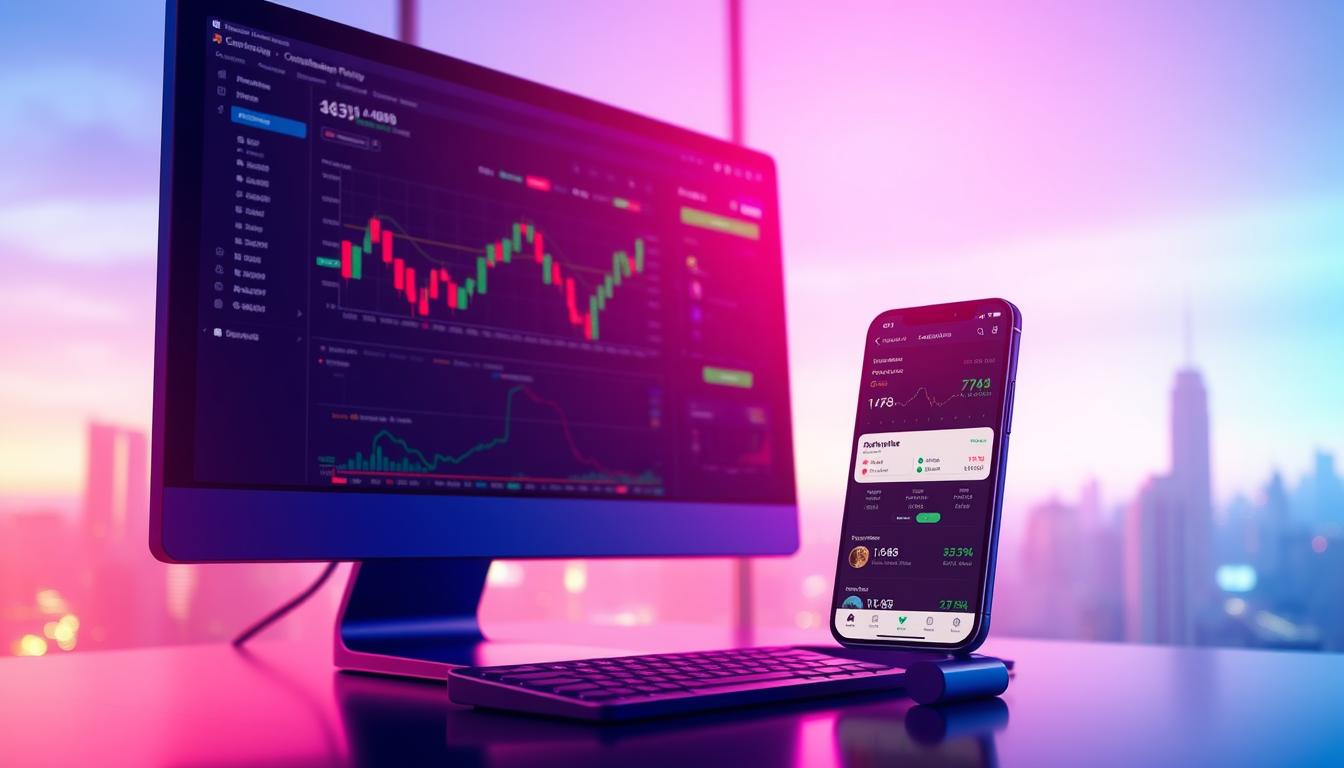Now Reading: AI Powered Crypto Staking Rewards Optimizer: Maximize Your Earnings
- 01
AI Powered Crypto Staking Rewards Optimizer: Maximize Your Earnings
AI Powered Crypto Staking Rewards Optimizer: Maximize Your Earnings

The world of digital currency investing is changing fast. Decentralized finance, or DeFi, has created new ways for people to earn money. By holding certain digital assets, you can now generate a healthy income.
This process, known as staking, has become incredibly popular. More than $35 billion is currently staked in Ethereum alone. Annual yield rates often range from 5% to 15%, showing its strong potential.
A new wave of technology is making this even better. Advanced tools now combine smart algorithms with blockchain mechanics. The goal is simple: help users get the highest possible returns on their investments.
These intelligent systems analyze many factors automatically. They look at network conditions, validator performance, and market trends. This removes the guesswork from manual staking approaches.
This article will guide you through this exciting development. We will explore how these platforms work and compare different options. You will learn actionable strategies to safely increase your cryptocurrency earnings.
Key Takeaways
- Staking allows you to earn rewards for holding certain digital currencies, with significant funds already committed to networks like Ethereum.
- New technological tools are emerging that automate the process of maximizing returns from your staked assets.
- These systems analyze multiple data points, including validator performance and market conditions, to optimize your strategy.
- Understanding how these platforms work is crucial for both new and experienced investors in the blockchain space.
- While generally lower risk than trading, success still depends on proper education and careful platform selection.
Understanding the Current Crypto Staking Landscape
The landscape of earning from digital currencies has expanded dramatically with staking protocols. This approach lets investors generate income simply by holding certain digital assets.
Fundamentals of Crypto Staking and DeFi
Decentralized finance platforms use a process called yield farming. Investors supply liquidity to various protocols and receive compensation.
When users lock their digital assets in smart contracts, they help support network operations. In return, platforms provide rewards through fee percentages or new tokens.

These rewards depend on the specific asset and platform model. The system creates a win-win situation for both networks and investors.
Recent Market Trends and Passive Income Opportunities
Billions of dollars now flow through various staking protocols across multiple networks. This shows strong investor confidence in the approach.
The returns significantly outperform traditional banking products. Annual yields often reach 5-15% compared to bank rates below 1%.
Investors enjoy greater flexibility with no minimum requirements. They can access emerging digital currencies before mainstream adoption.
This method offers relatively low risk compared to volatile trading. Blockchain security mechanisms protect staked assets throughout the process.
The Mechanics Behind AI Powered Crypto Staking Rewards Optimizer
Advanced computational systems are revolutionizing how investors approach digital asset management. These platforms process enormous amounts of blockchain data in real-time across multiple networks.
The technology identifies profitable opportunities that manual methods often miss. This creates significant advantages for users seeking maximum returns.
How Intelligent Processes Optimize Staking Yields
Machine learning algorithms continuously monitor various factors affecting staking outcomes. They track validator performance, reward patterns, and market conditions.
This constant analysis enables smart decisions about asset allocation. The system automatically adjusts positions based on changing circumstances.
Pattern recognition identifies optimal timing for transactions. Predictive analytics forecast reward trends with impressive accuracy.

Integrating Advanced Technology with Blockchain Systems
The integration of analytical systems with distributed ledger technology creates powerful synergy. Blockchain provides the secure, transparent framework for operations.
This combination enhances overall system performance through automation. It removes friction from traditional staking processes.
Neural networks process complex data from different protocols simultaneously. This allows efficient management across various networks without manual intervention.
The technical integration significantly improves reward generation efficiency. Users benefit from optimized outcomes with reduced effort.
AI powered crypto staking rewards optimizer
Modern technological solutions are reshaping passive income strategies in the blockchain ecosystem. These advanced platforms combine multiple analytical approaches to maximize returns.

Effective optimization solutions offer comprehensive features for digital asset management. They provide real-time monitoring across various networks.
The table below compares essential characteristics of different platform types:
| Feature Category | Basic Platforms | Advanced Solutions | User Benefit |
|---|---|---|---|
| Monitoring Capability | Manual checking required | Real-time automated tracking | Continuous optimization |
| Network Support | Single blockchain | Multiple protocols | Diversified opportunities |
| Risk Management | Basic alerts | Intelligent protocols | Enhanced security |
| Reward Reinvestment | Manual process | Automatic compounding | Maximized growth |
These platforms evaluate thousands of opportunities across different networks. They compare potential returns and validator reliability.
Users benefit from intuitive dashboards that display key metrics clearly. Customizable alert systems keep investors informed about portfolio changes.
The best solutions adapt automatically to shifting market conditions. They rebalance positions when better opportunities emerge.
Evaluating Traditional Versus AI-Enhanced Staking Platforms
When selecting tools for digital asset growth, users must weigh the merits of manual versus automated methodologies. This comparison helps investors choose the right approach for their specific needs and experience level.

Both types of platforms serve distinct purposes in the investment landscape. Understanding their differences ensures better decision-making for portfolio management.
Comparing Returns and User Flexibility
Traditional platforms offer direct control over investment choices. Users manually select validators and manage their positions with complete oversight.
Automated systems provide intelligent optimization through continuous analysis. These platforms typically generate higher returns by identifying optimal timing and allocation strategies.
Flexibility varies significantly between approaches. Manual systems give users hands-on control, while automated solutions handle optimization while allowing customization.
Security Considerations for Both Approaches
Security remains paramount for all investment platforms. Traditional systems rely on established blockchain protocols and user vigilance.
Enhanced platforms add protective layers through advanced monitoring. They detect anomalies and prevent potential threats proactively.
Both approaches require careful risk assessment. Investors should evaluate each platform’s security features before committing funds.
The choice depends on individual preferences and technical comfort. Each method offers distinct advantages for different types of users.
Key Features of an Effective DeFi Staking Platform
Investors seeking sustainable returns should prioritize specific platform features that ensure reliability and performance. The right choice combines strong economic models with robust technical foundations.
Tokenomics and Staking Payouts
Token economics determine long-term viability. Examine supply mechanics and inflation rates. Sustainable models maintain reward value over time.
Payout structures vary significantly between platforms. Look for consistent distribution frequencies and compounding options. Historical performance indicates reliability.
Smart Contract Integration and Network Security
Well-audited smart contracts eliminate intermediary risks. They automate reward distribution exactly as programmed. Transparency ensures terms cannot be manipulated.
Network security requires multiple protection layers. Cold storage for assets and insurance funds provide safety. Regular audits by reputable firms are essential.
The development team’s experience and community engagement demonstrate commitment. Supported currency variety and user-friendly interfaces complete the evaluation framework.
Exploring Top AI Blockchain Tools for Improved Crypto Operations
A new generation of intelligent platforms is emerging that bridge the gap between predictive analytics and secure ledger operations. These sophisticated tools combine advanced computational capabilities with distributed ledger technology to enhance digital asset management.
Innovative Tools that Enhance Transaction Efficiency
Modern blockchain solutions now incorporate machine learning to optimize transaction processing. These systems analyze network congestion patterns to recommend optimal timing.
The integration of analytical capabilities with distributed ledger technology creates powerful synergy. This combination improves overall system performance across various networks.
The table below compares different categories of advanced tools available for digital asset operations:
| Tool Category | Primary Function | Key Benefit | Platform Examples |
|---|---|---|---|
| Analytical Platforms | Predictive market analysis | Improved decision-making | Ethereum, Hyperledger |
| Transaction Optimizers | Fee reduction algorithms | Cost efficiency | Corda, NEO |
| Security Monitors | Real-time threat detection | Enhanced protection | Quorum, EOS |
| Portfolio Managers | Automated rebalancing | Optimized returns |
These advanced systems democratize access to sophisticated crypto operations. Individual users can leverage enterprise-level technology for better performance.
For comprehensive guidance on selecting the right solutions, explore the top AI blockchain tools available today. The right integration can significantly enhance your digital asset management strategy.
Designing a Winning Staking Strategy for Maximum Returns
Building a sustainable income stream through blockchain participation hinges on thoughtful strategy development and risk assessment. A well-structured approach balances potential gains with appropriate safety measures.
Successful investors recognize that careful planning separates consistent performers from occasional winners. They establish clear objectives before committing digital holdings.
Assessing Investment Risk and Reward
Evaluating potential returns requires understanding various risk factors. Network stability, validator performance, and lock-up periods all influence outcomes.
Diversification across multiple assets reduces exposure to single-point failures. Spreading holdings mitigates volatility while capturing different reward streams.
Timing decisions significantly impact overall performance. Market cycles and network developments create optimal entry and exit points for strategic positioning.
Position sizing determines what percentage of total holdings to allocate. Regular rebalancing maintains target allocations as values fluctuate over time.
Integrating Smart Contracts and Blockchain for Secure Staking
The foundation of secure digital asset management lies in the integration of self-executing contracts with distributed ledger systems. These automated agreements operate on blockchain technology to create tamper-proof environments for participation.
How Smart Contracts Enhance Transparency
Self-executing contracts provide complete visibility into all operations. Every transaction and reward distribution becomes permanently recorded on the distributed ledger.
Users can independently verify that terms execute exactly as programmed. This eliminates concerns about manipulation or hidden fees. The system creates transparency through publicly auditable code.
Advanced monitoring systems track validator performance in real-time. They ensure compliance with established protocols across different networks. This builds confidence among participants.
Security measures include multi-signature requirements for critical operations. Time-locked withdrawals prevent instant exploits. Emergency pause mechanisms offer additional protection layers.
Before committing assets, investors should review professional security audits. Examining contract source code and development team reputation ensures reliable participation. Understanding governance mechanisms controls upgrades effectively.
The Role of AI in Enhancing Crypto Trading and Staking Performance
Modern investment platforms leverage sophisticated algorithms to enhance both trading and staking outcomes simultaneously. These systems process massive data streams to identify optimal strategies across different market conditions.
Automated Analysis and Predictive Analytics
Intelligent systems examine historical patterns and real-time market data continuously. They detect subtle correlations that human analysis often misses.
Predictive models forecast price movements and reward fluctuations with impressive accuracy. This enables proactive adjustments before significant market shifts occur.
The technology analyzes social sentiment, trading volumes, and network metrics simultaneously. This comprehensive approach provides deeper market understanding than traditional methods.
Leveraging Machine Learning for Real-Time Insights
Advanced algorithms learn from each transaction and market movement. They continuously refine their predictive capabilities based on new information.
Real-time monitoring systems provide instant alerts about emerging opportunities. They track unusual volume patterns and security threats requiring immediate attention.
These tools optimize the relationship between active trading and passive staking activities. They identify optimal moments to convert profits between different investment approaches.
The systems maintain balanced portfolios that maximize overall returns. This integrated approach represents the future of digital asset management.
Navigating the Evolving Crypto and DeFi Landscape
The decentralized finance ecosystem continues to evolve at remarkable speed. New developments are transforming how investors approach digital asset management.
Understanding these changes helps position portfolios for future success. The landscape offers both challenges and significant opportunities.
Market Trends Shaping Future Staking Opportunities
Several key trends are reshaping the staking environment. Layer-2 scaling solutions improve transaction efficiency dramatically.
Liquid staking derivatives provide greater flexibility for participants. Cross-chain protocols enable engagement across multiple networks simultaneously.
The industry is expanding beyond basic yield generation. Sophisticated financial instruments now include tokenized positions and composite strategies.
Regulatory clarity is bringing institutional capital into staking markets. This establishes frameworks for sustainable long-term growth.
Technological innovations drive continuous improvement. Enhanced consensus mechanisms and interoperability protocols connect previously isolated ecosystems.
Mainstream adoption continues to accelerate market expansion. The diversity of crypto staking rewards available today reflects this dynamic growth.
Staying informed about emerging trends remains crucial for success. Identifying legitimate projects early creates significant advantages in this fast-moving industry.
Managing Data Security and Risk in Crypto Staking
Protecting your digital assets requires a comprehensive approach to security and risk management. A multi-layered strategy is essential to safeguard investments from various threats.
This involves understanding potential vulnerabilities and implementing strong protective measures.
Implementing Robust Security Mechanisms
Strong security starts with fundamental practices. Hardware wallets protect private keys from online threats. Multi-factor authentication adds a vital layer for account access.
For larger holdings, cold storage solutions provide offline protection. Encrypted communication channels prevent interception of sensitive data.
Advanced monitoring tools enhance these basic protections. They scan blockchain networks for unusual patterns continuously.
The table below outlines major risk categories and their characteristics:
| Risk Category | Primary Concern | Common Mitigation |
|---|---|---|
| Smart Contract | Coding vulnerabilities | Professional audits |
| Validator | Poor performance | Diversification |
| Liquidity | Locked assets | Emergency reserves |
| Market | Price volatility | Position sizing |
Effective risk management includes thorough due diligence. Diversifying across multiple networks avoids single points of failure.
Regular security reviews and performance tracking are crucial. These protocols help maintain a strong security posture over time.
Steps to Kickstart Your Journey in Crypto Staking Rewards
Newcomers to the world of decentralized finance can follow a structured approach to begin earning. This process involves careful platform selection and understanding the fundamental steps.
Practical Tips and Actionable Strategies
Begin with small amounts while learning the system. Focus on established digital assets with proven track records.
Research each platform thoroughly before depositing funds. Understand lock-up periods and withdrawal terms clearly.
Diversify across multiple assets rather than concentrating in one. This reduces risk while capturing different reward streams.
Tools and Platforms to Get Started
Several reputable exchanges offer excellent staking services. These platforms provide user-friendly access to various opportunities.
Binance supports over 100 cryptocurrencies with flexible options. Coinbase offers automatic reward distribution for beginners.
Kraken focuses on on-chain staking with strong security features. Each platform allows users to start with minimal experience.
The right tools and services provide the support needed for success. Choose platforms that match your investment goals and risk tolerance.
Conclusion
Digital asset management has reached a pivotal moment with the maturation of decentralized finance protocols. The crypto staking landscape offers substantial returns, with some platforms delivering over 24% APY.
Optimized solutions provide clear advantages through intelligent automation and risk management. This technology enables users to maximize earnings while maintaining security across various blockchain networks.
The industry continues rapid growth, creating new opportunities for investors. Success requires careful platform selection and diversified strategies.
Begin your journey with reputable services and small positions. The future of digital asset investment looks promising as technology advances.
FAQ
What is the primary benefit of using an AI optimizer for my digital asset investments?
The main advantage is the potential for significantly higher returns. These platforms use advanced algorithms to analyze various blockchain networks and protocols. They automatically shift your funds to the most profitable opportunities, saving you time and effort while aiming to maximize your passive income.
How does this technology differ from traditional DeFi management methods?
Traditional methods often require manual research and constant monitoring of the market. An AI-enhanced solution automates this process. It leverages machine learning to assess risk, predict performance, and execute strategies with a speed and precision that is difficult to achieve manually, offering greater user flexibility.
Are my holdings secure on these automated platforms?
A> Security is a top priority. Reputable services integrate with audited smart contracts on established blockchain networks. These contracts enhance transparency and reduce counterparty risk. However, it’s crucial to use platforms with a strong track record and robust security mechanisms to protect your finances.
What kind of features should I look for in a top-tier staking service?
Key features include a user-friendly interface, support for multiple cryptocurrencies, transparent fee structures, and clear information on tokenomics. Look for integration with reliable protocols, strong customer support, and tools that provide detailed analytics on your investment performance.
Can beginners use these tools effectively?
Absolutely. Many platforms are designed with accessibility in mind. They simplify complex operations, making it easier for newcomers to participate in the industry. Starting with a small amount to understand the features and associated risks is a recommended strategy for growth.
How does the integration with blockchain technology work?
The optimizer connects directly to various blockchain networks via secure application programming interfaces (APIs). This allows it to read on-chain data, monitor transaction confirmations, and interact with smart contracts to manage your assets without holding your private keys, maintaining a high level of security.














